Identifying Toads in California
California Frogs and Toads: |

Many toads found in California are very similar in appearance. You can tell them apart by some distinct and some more subtle characteristics. The location where a toad is found can also help you to identify the species. Some toads found in California have a very limited range. Check the range maps to see if a particular species of toad is found in your area. If not, continue down the list. You may want to try using a California Toad Key I have made which tries to categorize the toads based on whether or not they have a stripe on the back (Dorsolateral Stripe) and raised crests on the head (Cranial Crests.) |
||
| Sonoran Desert Toad Incilius alvarius |
||
The Sonoran Desert Toad once occured in parts of the Imperial Valley and along the Colorado River. It seems to have totally disappeared from California. If you find one in California, let me or somebody know! It is characterized by large long parotoid glands, a cranial crest, a lack of a dorsal stripe, and large white warts behind the eye and on top of the rear thigh. It is generally green or olive in color without very dark spots or blotches. It would occur along with Rocky Mountain Toads, Red-spotted Toads, and Great Plains Toads, but both should be readily distinguished by its color, size, parotoid glands and warts. |
||
 |
 |
 |
| Large size, no mid-dorsal stripe, green or olive color | ||
 |
 |
|
| Historic range - in red |
Enlarged elongated parotoid glands, cranial crests, and white warts. |
|
| Black Toad Anaxyrus exsul |
||
The Black Toad occurs only in Deep Springs Valley southeast of Bishop near the Nevada Border. It occurs with the Great Basin Spadefoot, but is entirely different in appearance, being dark black with a stripe down the middle of the back. |
||
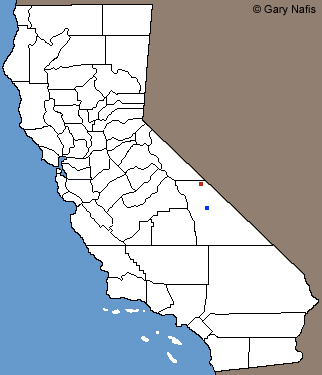 |
 |
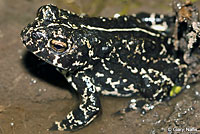 |
| Black coloring with a light mid-dorsal stripe |
||
 |
 |
|
| Range - in red (Blue = introduced population in Saline Valley) |
||
| Arizona Toad Anaxyrus microscaphus |
||
The Arizona Toad only occurs in a small area just west of the Colordo River, although it may not occur in California anymore. The lack of a stripe on the back, and the large long parotoid glands will differentiate this toad from others that inhabit the same area. |
||
 |
 |
 |
| Large long parotoid glands, no mid-dorsal stripe, often a light mark between the eyes |
||
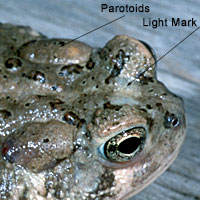 |
||
| Possible historic range - in red |
Large elongated parotoid glands Light mark between eyes |
|
| Yosemite Toad Anaxyrus canorus |
||
Males and females vary in appearance. Yosemite toads only occur at high elevations in the Sierra Nevada Mountains. They do not occur with any other species of toad, although the California Toad occurs nearby. The California toad has a distinct light dorsal stripe while the Yosemite Toad has a faint light stripe or no stripe. |
||
 |
 |
 |
| Female | Male | |
| Dorsal stripe is faint or absent. Females with dark markings |
||
 |
||
| Historic range - in red | Faint dorsal stripe |
|
The ranges of the following toads overlap in some areas, making their identification a little more difficult. Check the range maps to learn which of these toads occurs in your area, then pay attention to some of the basic details listed below. |
||
| Rocky Mountain Toad Anaxyrus woodhousii woodhousii (formerly Bufo woodhousii woodhousii) |
||
The Rocky Mountain, or Woodhouse's Toad has spread into California in the far southeast, along the Colorado River and the Imperial Valley to near Palm Springs. The light stripe on the back will help you distinguish it from the Red-spotted Toad. The presence of long parotoid glands and an enlarged cranial crest will help you distinguish it from the California Toad. |
||
 |
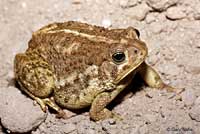 |
 |
| Light mid-dorsal stripe, long parotoid glands, enlarged cranial crests |
||
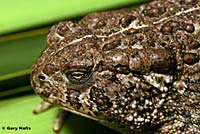 |
 |
|
| Range - in red | Elongated paratoid glands behind the eyes |
Enlarged cranial crests between eyes |
 |
||
| Comparison of Anaxyrus cognatus on right and Anaxyrus woodhousii on left. The cranial crests of A. cognatus point inward at the front, often coming together. The parotoid glands of A. woodhousii are more elongated than on A. cognatus. |
||
| Great Plains Toad Anaxyrus cognatus (formerly Bufo cognatus) |
||
The Great Plains Toad occurs in the far southeast, along the Colorado River and the Imperial Valley to near Palm Springs. It has cranial crests and elongated parotoid glands which will help you distinguish it from the Red-spotted Toad, which has no cranial crests and rounded parotoid glands, and California Toads, which have no cranial crest and a stripe down the back. The large blotches with light edges will help you distinguish it from the Rocky Mountain Toad, which also tends to have a more pronounced stripe down the back. |
||
 |
 |
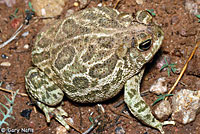 |
| Elongated parotoid glands, cranial crests, faint mid-dorsal stripe or none at all |
||
 |
 |
|
| Range - in red | Cranial crests converge at the front | Elongated paratoid glands |
 |
||
| Comparison of Anaxyrus cognatus on right and Anaxyrus woodhousii on left. The cranial crests of A. cognatus point inward at the front, often coming together. The parotoid glands of A. woodhousii are more elongated than on A. cognatus. |
||
| Red-spotted Toad Anaxyrus punctatus (formerly Bufo punctatus) |
||
The Red-spotted Toad occurs in Southern California, mainly in the deserts east of the mountain ranges and north through much of the Mojave Desert. It's small, rounded parotoid glands and lack of a back stripe will distinguish it from its neighbors. It often has many red spots on the body, but sometimes the red is lacking. |
||
 |
 |
 |
| Small rounded parotoid glands, no mid-dorsal stripe. Often with many red-spots. |
||
 |
 |
|
| Range - in red | Rounded paratoid glands Red spots on back |
No stripe or faint stripe on the middle of the back |
| Western Toad Anaxyrus boreas (Two subspecies occur in California) |
||
Western Toads are found throughout much of the state, excluding the high Sierras and the deserts (although they can be found in some desert towns.) There are two subspecies, as indicated by the map below. A light stripe down the middle of the back and horizontal pupils should help you distinguish these toads from other toads, frogs and spadefoots occurring in the same area. |
||
 |
 |
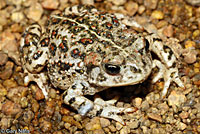 |
| Boreal Toad Anaxyrus boreas boreas (Bufo boreas boreas) |
California Toad Anaxyrus boreas halophilus (Bufo boreas halophilus) |
|
 |
 |
|
| Historic Range: Red: California Toad Orange: Boreal Toad (Gray is approximate range of intergradation.) |
Distinct mid-dorsal stripe, slightly elongated parotoid glands, no cranial crests. | |
| Comparison of subspecies of Anaxyrus boreas | ||
| A. b. boreas: "Considerable dark blotching both above and below. Sometimes almost all dark above..." A. b. halophilus "Generally less dark blotching than in Boreal Toad. Head wider, eyes larger (less distance between upper eyelids), and feet smaller." (Stebbins, 2003) |
||
| Arroyo Toad Anaxyrus californicus |
||
The Arroyo Toad occurs along the south and south-central coasts. The lack of a stripe down the middle of the back, non-enlarged toe pads, horizontal pupils, enlarged parotoid glands, and usually a light mark on the head between the eyes, will help you distinguish this toad from other frogs, toads, and spadefoots occurring in the same area. |
||
 |
 |
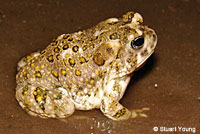 |
| No mid-dorsal stripe, enlarged parotoid glands, usually a light mark between the eyes |
||
 |
||
| Range - in red | Parotoid glands are oval. Cranial crests are not present. Usually a light mark across the head between the eyes |
|
Return to the Top
© 2000 -
